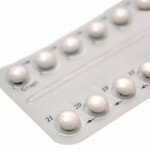The diagnosis of "endometriosis" is preceded by many types of research. Identify it, based only on indirect signs, is not always capable of even a doctor. But to understand that in the reproductive sphere everything is not all right, a woman is available to herself, as the endometriosis symptoms, excretions, are different from what usually happens.
Symptoms of endometriosis
 The replacement layer of the uterine mucosa should lining it from the inside. Managing various causes of its cells penetrate into other parts of the body. An indispensable feature of the particles of the uterine mucosa is that they retain all its inherent properties, wherever located.
The replacement layer of the uterine mucosa should lining it from the inside. Managing various causes of its cells penetrate into other parts of the body. An indispensable feature of the particles of the uterine mucosa is that they retain all its inherent properties, wherever located.
If the process is still at the very beginning, it is possible that endometriosis will not show symptoms and provoke special discharges explicitly. But menstruation will pass differently than before.
With the development of malaise, all symptoms are more noticeable.Pain
Pain syndrome is found a few days before the critical. It is similar to the sign of PMS, but it manifests itself with greater force. The reason for it is not so much the activity of smooth muscles of the uterus, as the presence of cells, similar to the component of the endometrium, in other parts of the body. These tissues develop in accordance with the stages of the cycle, that is, they thicken and press on the neighboring ones.
Pain is usually felt in the lower abdomen and lower back. But since the cells of the uterine mucosa can take root outside the reproductive system, it is likely in the region of the bladder, intestine. In these areas, pain also reminds oneself in critical days, intensifies with urination and during defecation.

Allocations in the menstrual period
Discharge in endometriosis is the first sign of trouble. They are also present in healthy women, but since they do not cause significant trouble, few people notice their character. Meanwhile, this sign will more likely tell about the trouble, because not only the changes in menstruation change, but also the secretory fluid produced by the cervix.
The nature of the monthly - the main thing that signals the health or problems of the reproductive system. Not an exception and endometriosis. With this diagnosis, the volumes of the tissues of the uterine mucosa increase quantitatively. Having the same properties as the healthy cells that have left the inner space of the cell, the cells develop according to the days of the cycle. And when menstruating exfoliate, replacing the new ones. This makes monthly excretions in endometriosis of the uterus:
-
 Abundant. Their intensity becomes noticeably higher from the initial stage of the disease and regardless of its type. Obviously this is with adenomyosis, that is, the introduction of endometrial cells into the next section of the uterus - the myometrium. The tissues of the mucous membrane from the muscle layer go in the same way as normal, hence the increase in the total number of secretions;
Abundant. Their intensity becomes noticeably higher from the initial stage of the disease and regardless of its type. Obviously this is with adenomyosis, that is, the introduction of endometrial cells into the next section of the uterus - the myometrium. The tissues of the mucous membrane from the muscle layer go in the same way as normal, hence the increase in the total number of secretions; - Changed the color. The pathological tissue has the same structure as the healthy one. That is, in its composition there are blood vessels. When menstruating, they are damaged more intensively than in the endometrium, due to the fact that when detachment is encountered mechanical obstacles. Therefore, the total volume of blood released from the genital tract on critical days is much greater. And the discharge becomes bright red, brown or even black. This characteristic of discharge is changing not only because of the increased concentration of blood, but also the possibilities for its oxidation;
- Long. Replaceable with menstruation tissue do not have time to go completely beyond the standard period, occupying a maximum of 7 days. The intensity of excretions before the end of menstruation is not always the same, by the end they take on the form of an ointment. But it can last longer than a week. Because of the uneven development of healthy and pathological mucosa, and menstrual flow is preceded by scant excretions;
- Changed the consistency. The appearance of endometrial cells in other areas of the abdominal cavity or uterus provokes inflammation. Often it is the cause, not the consequence of pathology. But its existence leads to the fact that clots are found in the secretions, and in general the mucus becomes more viscous.
Intermenstrual secretions
 Bloody discharge in endometriosis with the development of pathology and the spread of mucosal particles beyond the boundaries of the uterus, a general increase in their volume with adenomyosis occur outside of menstruation. The reason for this is the unevenness of their growth in different areas.
Bloody discharge in endometriosis with the development of pathology and the spread of mucosal particles beyond the boundaries of the uterus, a general increase in their volume with adenomyosis occur outside of menstruation. The reason for this is the unevenness of their growth in different areas.
Appearance with blood can appear:
- When defecating and urinating, if the cells of the inner shell of the uterus have settled in the bladder or intestine;
- After a gynecological examination or sex, if the pathology has affected the cervix or vagina;
- Without obvious reasons, simply because there are a lot of mucus accumulated on some sites. However, the emergence of excreta and physical effort.

Endometrial cells are viable, so they can infiltrate into the lymphatic vessels. This pattern is typical for adenomyosis. Therefore, except for other signs, colorless mucus with a sharp smell can be found in large quantities.
We should not be surprised at the occurrence of inflammation in endometriosis, which discharge will be at the same time, depends on the degree of its development, as well as provoked the malaise of the cause. If an infection has served him, or she started later( which is real because of decreased immunity), there will be purulent inclusions. They will be seen both on critical and on other days of the cycle. To distinguish them easily by the whitish or yellow-green color, is a specific smell.
 We recommend reading an article on the treatment of endometriosis in women. You will learn about the features of the disease, the appointment of medication, the appointment of hormonal and non-hormonal drugs.
We recommend reading an article on the treatment of endometriosis in women. You will learn about the features of the disease, the appointment of medication, the appointment of hormonal and non-hormonal drugs.
Late manifestations of the disease
The development of endometriosis, possible with the prolonged absence of professional assistance, provokes signs concerning not only the functions of the reproductive organs. Increased blood loss, regularly painful pains, imbalance of hormones to which this is all accompanied, are the cause:
- Decline, fainting;
- Anemia;
- Nervous disorders.
Endometriosis gives symptoms and excretions that occur in other lesions of the reproductive organs. Therefore, after discovering them, one should not try to get rid of pathological manifestations on their own.
